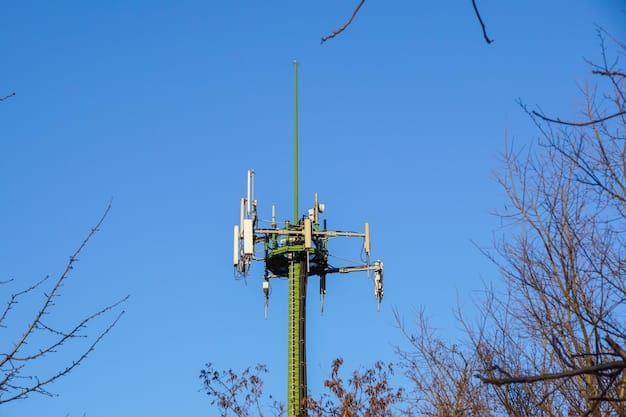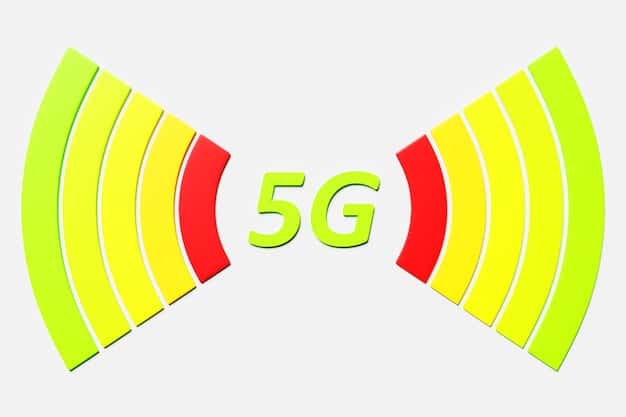Millimeter Wave 5G: How US Businesses Can Unlock 20 Gbps Speeds

Millimeter Wave (mmWave) 5G offers US businesses unprecedented speeds up to 20 Gbps, enabling transformative applications like enhanced video conferencing, augmented reality, and IoT deployments, but requires careful consideration of deployment challenges and strategic planning to maximize its potential.
Are you ready to experience internet speeds like never before? Millimeter Wave 5G: How US Businesses Can Leverage Its 20 Gbps Speeds is transforming the connectivity landscape, and US businesses stand to gain immensely. Let’s dive into how you can harness this powerful technology.
Understanding Millimeter Wave 5G Technology
Millimeter wave (mmWave) 5G is a cutting-edge technology that promises incredibly high data speeds and low latency. It operates on a different frequency spectrum compared to traditional cellular networks, allowing for faster and more efficient data transmission. Let’s explore the fundamentals of this technology.
What is Millimeter Wave?
Millimeter wave refers to the spectrum between 30 GHz and 300 GHz. These high-frequency waves offer significantly more bandwidth than the frequencies used by previous generations of cellular technology.
Key Advantages of mmWave 5G
The most significant advantage of mmWave 5G is its speed. With potential speeds reaching up to 20 Gbps, it far surpasses the capabilities of 4G LTE and lower-band 5G. Other benefits include:
- Ultra-low latency, enabling near real-time responsiveness.
- Increased network capacity, supporting a higher density of connected devices.
- Enhanced reliability for critical applications.

In summary, millimeter wave 5G is a game-changing technology poised to revolutionize how businesses operate, offering unparalleled connectivity and performance in demanding applications.
Benefits for US Businesses
The introduction of millimeter wave 5G brings a host of opportunities for US businesses. Enhanced connectivity translates directly into improved efficiency, innovation, and customer experiences. Let’s examine these benefits in detail.
Enhanced Video Conferencing and Collaboration
With mmWave 5G, businesses can conduct seamless video conferences with crystal-clear quality and minimal lag. This enhances remote collaboration and enables more effective communication among teams.
Augmented Reality (AR) and Virtual Reality (VR) Applications
The high bandwidth and low latency of mmWave 5G make it ideal for AR and VR applications. Businesses can leverage these technologies for training, product demonstrations, and immersive customer experiences.
- Improved training simulations for employees.
- Interactive product demos for potential customers.
- Enhanced remote support and maintenance using AR overlays.
Overall, the benefits of millimeter wave 5G are substantial and far-reaching, offering US businesses a competitive edge in an increasingly connected world. Businesses can expect to see faster operations, better customer experiences, and more impactful innovations.
Challenges in Deploying mmWave 5G
While mmWave 5G offers remarkable potential, deploying it is not without its challenges. Understanding these challenges is crucial for businesses planning to adopt this technology. Let’s explore some of the key hurdles.
mmWave signals have a shorter range and are more susceptible to interference from obstacles like buildings, trees, and even weather. This requires a denser network of cell sites for adequate coverage.
Infrastructure Requirements and Costs
Deploying mmWave 5G requires a significant investment in infrastructure. Small cells, fiber optic cables, and other equipment are necessary to build a robust network. These costs can be substantial, especially for businesses in urban areas.
Regulatory and Permitting Issues
Navigating the regulatory landscape can be complex. Obtaining permits for installing small cells on public infrastructure involves dealing with local governments and adhering to various regulations. This process can be time-consuming and costly.

Despite these challenges, the benefits of mmWave 5G often outweigh the costs, particularly for businesses with a strong need for high-speed, low-latency connectivity. Careful planning and strategic partnerships can help overcome these obstacles.
Strategic Planning for mmWave 5G Adoption
To effectively leverage millimeter wave 5G, US businesses need to develop a comprehensive adoption strategy. This involves assessing specific needs, evaluating available solutions, and planning strategically for deployment. Let’s consider some essential steps.
Assess Your Business Needs
Begin by identifying the areas where mmWave 5G can have the most significant impact. Consider applications like remote collaboration, IoT deployments, and customer engagement.
Evaluate Available Solutions
Research different vendors and service providers offering mmWave 5G solutions. Compare their offerings, pricing, and coverage areas to find the best fit for your business.
- Review vendor case studies and testimonials.
- Conduct pilot tests to evaluate performance in your specific environment.
- Assess the scalability of the solutions to accommodate future growth.
In conclusion, strategic planning is essential for successful mmWave 5G adoption. By carefully assessing their needs and selecting the right solutions, US businesses can unlock the full potential of this transformative technology.
Use Cases in Various Industries
Millimeter wave 5G offers a myriad of applications across various industries. From healthcare to manufacturing, the technology’s high speed and low latency can revolutionize how businesses operate. Let’s explore some compelling use cases.
Healthcare: Remote Patient Monitoring
mmWave 5G enables real-time remote patient monitoring, allowing healthcare providers to track vital signs and provide timely interventions.
Manufacturing: Enhanced Automation
With mmWave 5G, manufacturers can implement advanced automation systems, improving efficiency and reducing downtime. High-speed connectivity supports real-time data analysis and control of robotic systems.
- Real-time monitoring of production lines.
- Automated quality control using AI-powered vision systems.
- Predictive maintenance to minimize downtime.
To summarize, the versatility of millimeter wave 5G means it can be adapted to suit the needs of various industries. Businesses that embrace this technology stand to gain significant competitive advantages.
Future Trends and Developments
The future of millimeter wave 5G is promising, with ongoing developments aimed at improving its performance, coverage, and accessibility. Staying abreast of these trends is crucial for businesses looking to stay ahead of the curve. Let’s delve into some key areas.
Researchers are continually working on ways to improve the range and penetration of mmWave signals. This includes developing advanced antenna technologies and signal processing algorithms.
Integration with Edge Computing
Combining mmWave 5G with edge computing can bring data processing closer to the source, further reducing latency and improving the responsiveness of applications. This is particularly beneficial for IoT deployments and real-time analytics.
Standardization and Interoperability
Ongoing efforts to standardize mmWave 5G technology will enhance interoperability among different vendors and devices, making it easier for businesses to integrate the technology into their existing infrastructure.
In essence, the future of millimeter wave 5G looks bright, with continuous innovations poised to extend its capabilities and benefits across various sectors. By staying informed and adaptive, US businesses can harness the full potential of this technology.
| Key Point | Brief Description |
|---|---|
| 🚀 Speed & Capacity | mmWave 5G delivers up to 20 Gbps, enhancing network capacity. |
| 🏢 Business Benefits | Improves collaboration, AR/VR applications, and customer experiences. |
| 🚧 Deployment Hurdles | Signal range and infrastructure costs pose deployment challenges. |
| 💰 Strategic Planning | Assess needs and research solutions for effective adoption. |
Frequently Asked Questions (FAQ)
▼
mmWave 5G utilizes high-frequency radio waves to deliver significantly faster speeds and lower latency compared to previous generations of cellular technology. The operating spectrum is between 30 GHz and 300 GHz.
▼
mmWave 5G can achieve speeds up to 20 Gbps, which is substantially faster than 4G LTE, which typically offers speeds ranging from 10 Mbps to 100 Mbps. This enhanced speed transforms many industries.
▼
The main challenges include its limited range and susceptibility to interference from buildings and trees. This requires a denser network of small cell sites, along with higher deployment costs.
▼
Industries such as healthcare, manufacturing, entertainment, and transportation stand to gain significantly. Remote patient monitoring, enhanced automation, and immersive experiences can be enhanced with mmWave 5G.
▼
Businesses should assess their connectivity needs, evaluate available solutions, and develop a strategic deployment plan. Additionally, it’s vital to stay informed about any regulatory considerations and associated costs.
Conclusion
In conclusion, millimeter wave 5G represents a significant leap forward in wireless technology, offering US businesses unprecedented speeds and opportunities. While there are challenges to deployment, the potential benefits for various industries are immense, driving innovation and transforming how businesses operate.





